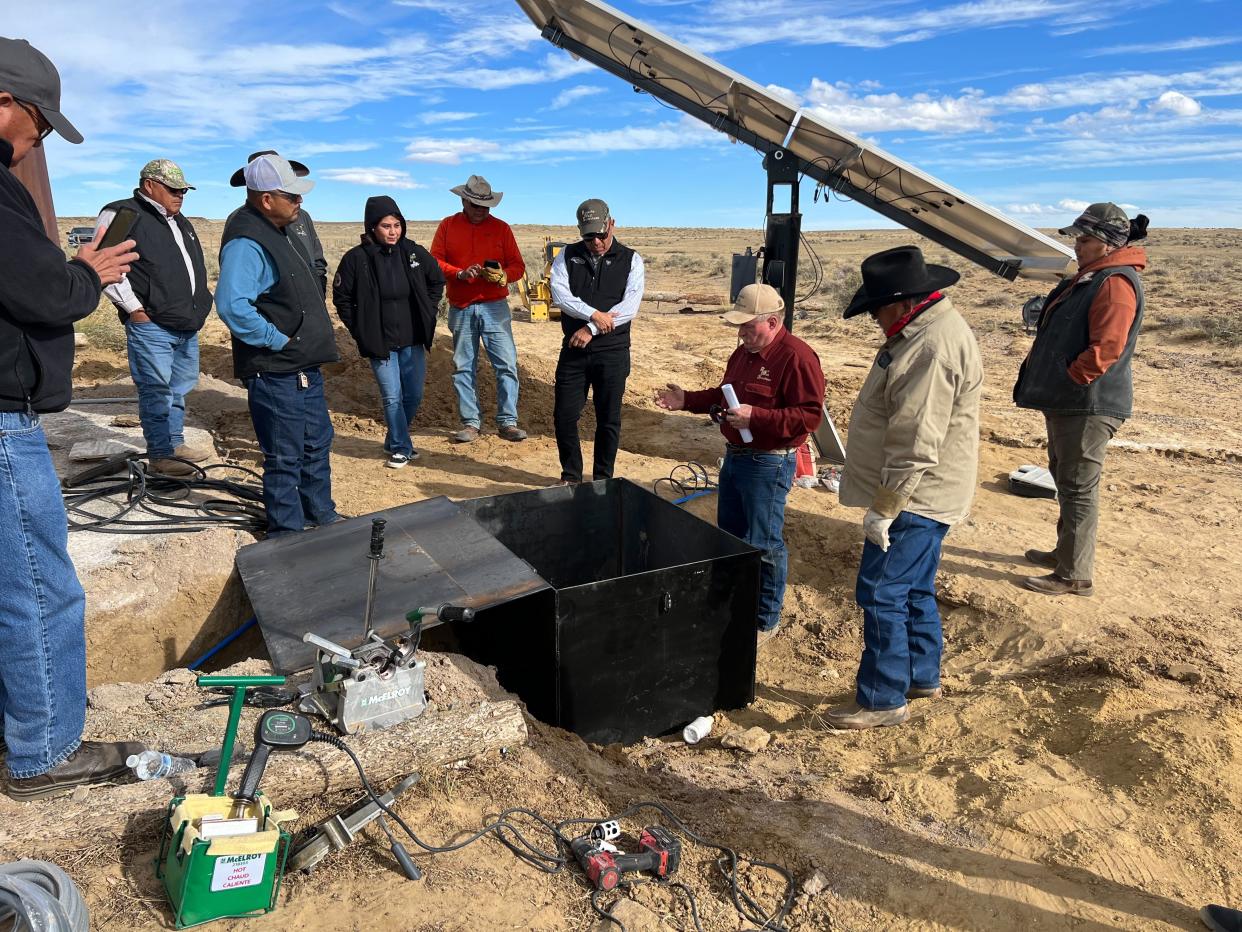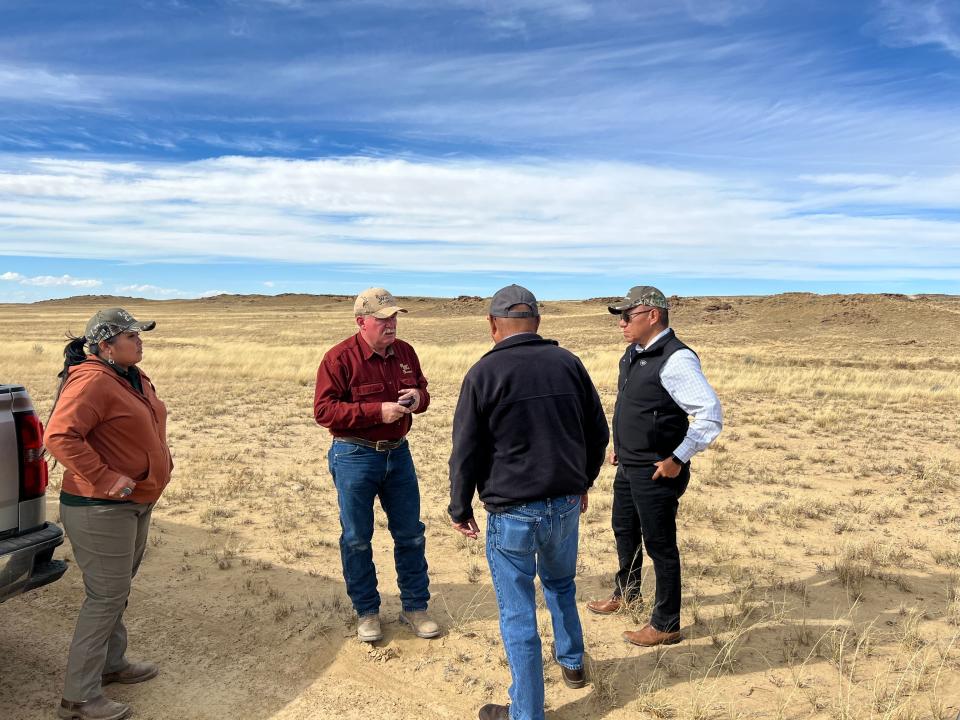NMSU Arrowhead client helps find solution to water woes of Navajo ranchers

Navajo Nation rancher George Tso has been involved with agriculture his entire life, from helping with his father’s alfalfa crops to sell to ranchers to working on his own nine-square-mile ranch in Farmington, New Mexico.
While Tso has plenty of room to raise additional cattle other than the 51 head he currently maintains, his biggest obstacle is water. The only water source on his land is located on the southern side of his ranch, but the best grazing for his cattle is on the northern side.
“It’s impossible to raise cattle with that one water drinker there,” Tso said. “I kept nagging (the Navajo government) that I needed water, but I was told to reduce my cattle by 10 percent, so I reduced. There’s a lot of grass in the northern part of the ranch, but my cattle don’t want to go that far to graze.”
If the cattle stay in one area, Tso said, the grass there is depleted, which causes the cattle to lose weight. Meanwhile, the grass grows plentifully in the other areas.
Mike Lisk, founder and CEO of Remote Well Solutions in Cloudcroft, New Mexico, decided to step in to help Navajo ranchers like Tso, who for years have had to travel miles just to haul water back to their ranches for their cattle. The company has designed and received both United States and international patents for an off-grid water production and distribution system that will replace old windmills with solar and solar/generator hybrid-powered systems that operate automatically off grid to electrically pump water from wells, then distribute the water to multiple watering points.
“I have a cattle ranch in Lincoln County with 125 animal units. When I visit a Navajo Nation tribal ranch, I find they have better land with more forage than mine, but only have about 20 to 30 animal units,” Lisk said. “I have water distributed across my ranch, but they have one windmill and one water trough in one spot. Dramatic improvements in efficiency will result very quickly for the cattle, ranch and the rancher as the water challenges are solved. Quantifiable results will be almost immediate.”

Lisk worked with Arrowhead Center at New Mexico State University on a 2018 study on the economic impacts of the installation of the Remote Well Solutions systems in McKinley County. The study, written by Arrowhead Center Program Director Kramer Winingham, Enterprise Advisor Dale Spencer, and then-graduate student Ejiro Osiobe, used an economic modeling software and found carrying capacities on ranches in McKinley County are four animal units per section on average.
In a likely scenario, carrying capacities increase 100% to eight animal units per section with the installed Remote Well Solutions technology. While this is still lower than typical New Mexico ranches, the project will help support more than 200 additional jobs in the state annually, and annually contribute nearly $18 million to the state’s economy.
“In terms of return on investment, this is one of the best economic development opportunities I’ve ever seen,” Winingham said. “The technology can double or triple the revenue potential of ranches in the area. It’s very exciting to see the Navajo Nation supporting the implementation of this new technology. The potential impact of Remote Well Solutions is significant in the Navajo Nation and beyond, as it can address challenges at similar ranches throughout the Southwest.”
“This new water production and distribution project technology developed by Remote Well Solutions is a huge step in the right direction in support our local Navajo ranchers,” said Myron Lizer, who was Navajo Nation vice president when the Remote Well Solutions project was first launched. “This system will increase our local ranchers’ yield and improve the grazing lands, as cattle do not have to center around on one watering point.”
Lizer said the project will also have a profound impact on the nation’s economy, as well as help ranchers prolong their equipment, fuel and finances.
“In the many years we have worked with Mike Lisk, we have been very impressed with his inventiveness and persistence to bring this new technology to market,” said Kathy Hansen, director and CEO of Arrowhead Center at NMSU. “We are excited to be able to help commercialize a New Mexico-developed technology that is solving real challenges in New Mexico.”
Remote Well Solutions is working with the Navajo Nation Department of Agriculture to break ground on additional projects within the eastern region of the Navajo Nation, which consists of regions in Utah, Arizona and New Mexico. Last year, Remote Well Solutions received a $500,000 contract to build the wells after years of planning.
“This will allow better usage of range forage vegetation on our tribal ranches, distribute water away from primary ranch water sources, improve cattle weight gains, improve profits for our ranches and increase revenues to our ranch leasing program,” said Ferdinand Notah, program and project specialist for the Navajo Department of Agriculture.
That comes as good news for ranchers like Tso, who hopes he can grow his ranch once the system is in place.
“It will benefit everybody. We can raise more cattle and get more money off of that, and in return buy the things we need to run a ranch,” Tso said.
This article originally appeared on Farmington Daily Times: NMSU Arrowhead client helps find solution to water woes of Navajo ranchers

